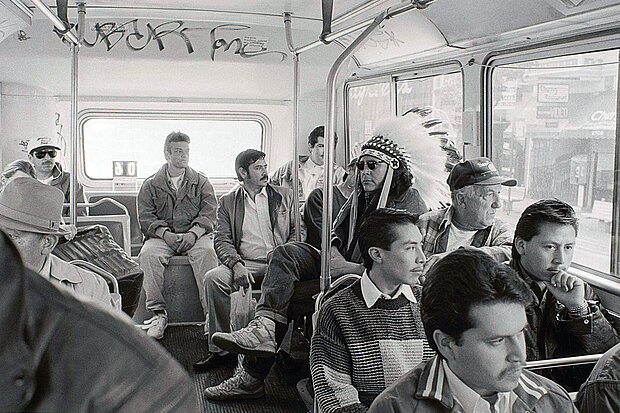
The NDSU Memorial Union Gallery is currently featuring Zig Jackson’s Guggenheim Award-winning photograph series. Jackson, whose native name is Rising Buffalo, is the first Indigenous photographer to win a Guggenheim Award.
He has created eight series of photos but his most famous is “Entering Zig’s Indian Reservation.” This series is a collection of 40 self-portraits on display through March 1.
To get to know more about Jackson and his photography journey, continue reading.
Q: What’s your background in photography?
A: I was always an artist growing up on the plains of North Dakota. I first picked up drawing at St. Joe’s Indian School in Chamberlain, South Dakota, then went on to St. Mary’s in New England, North Dakota; then studied more art at Intermountain Indian School in Brigham City, Utah.
I went onto Bacone, Jr. College in Muskogee, Oklahoma, in [the] early 80’s and was fascinated about tribal arts in Oklahoma. I went on to study art at Northeastern Oklahoma State in Tahlequah, Oklahoma.
I later wanted to work on a master’s in education at UNM in Albuquerque NM. That’s when I got more into photography. UNM at that time was one of the top photo schools in the nation. I didn’t know that: I just wanted to create art with my camera.
I taught at SFAI in Santa Fe [at] American Indian Art Institute with renowned photographer Meridel Rubenstein. I went on to get an MFA in photography at the San Francisco Art Institute, where Ansel Adams started the school. I was a TA to Pirkel Jones who was Ansel’s last assistant, TA to Jerry Bruchard the great street photographer, and many great instructors during my studies in the Bay Area.
Q: What meaning does this specific piece hold?
A: Each piece, each image is real, and has stories behind it. Each image is made to educate, to let people know that image-making is powerful and that a camera is a powerful tool.
Q: What elements do you believe helped your piece win the Guggenheim Award?
A: Documenting the Native American Indian of today. Knowledge of tribal peoples’ hardships and problems in today’s world. We’re still here creating, we’re still here and powerful, we still have our ways, and the love of the land. These aren’t tribal peoples in North Dakota, these are peoples all over the United States. I travel to all reservations. My photography becomes a voice for these peoples.
Q: What does this award mean to you?
A: [It] means so much! But not for me. It’s for every kid who loves and follows his heart in the arts; loves what joy image making can bring; that poorest of poor kid that was raised on an Indian reservation, who loved creating, that went on and became something. It’s for them.
If you want to learn more about Jackson and his works, a free reception and talk are scheduled for March 1 at 5 PM, and Jackson is set to speak around 5:30 PM.
